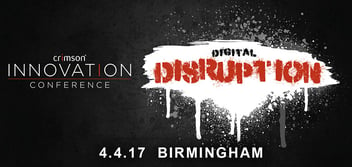Digital transformation: What techniques do CIOs use to drive change?
Business leaders are becoming increasingly aware that their competitors could unveil a new disruptive innovation at any time. Such disruptions have the potential to topple major organisations and transform entire industries.
To reduce the possibility of this happening, organisations must adopt cutting-edge ideas and embrace digital technologies. In most cases, it is the CIO’s / technology leader’s responsibility to drag the organisation into the 21st century. This is not easy, particularly for large companies that have powerful strong-willed stakeholders and ancient legacy systems that are vital for day-to-day operations.
In this article, Crimson’s IT solutions consultants highlight five actions that CIOs can take to drive change within their organisation.
Action 1 - Focus on the vision:
To ensure that your digital transformation strategy remains on course, you need to make certain that everyone in your organisation, from the most junior member of your team to the chief exec, is focused on achieving your strategy’s objectives. As the IT leader, you need to explain to your team how their individual actions can bring about change and show stakeholders a roadmap for success.
“The most important thing is getting your people aligned around a purpose and a mission that is bigger than themselves, and that they can get excited about coming to work every day. We lead people not projects,” Wayne Shurts, CTO of $50.37billion US food distributor Sysco, told ComputerWorld.
Having a clear vision is not only great for motivation, it also creates shared ownership of a common cause and adds transparency to the project.
Action 2 - Act fast and simple:
Your digital strategy should be split up into achievable weekly goals. Plan the change process in small stages, make each increment direct and understandable, and give it an owner. This will help you monitor your transformational timeline, add accountability to the project, improve information for stakeholders, and increase chances for collaboration.
This approach will also make your teams more agile because it will get them used to reacting rapidly and logically to change.
Action 3 - Modernise to create a single view:
To achieve lightening quick scalability, CIOs should aim to make operations more consistent across their organisation. Not only will this make updates and initiatives easier and quicker to implement but it will improve access to data, give a single view to users, and create joined-up cohesive services for customers.
Action 4 - Design for humans:
CIO.com has suggested that CIOs are more likely to drive change successfully if they design solutions specifically for individual human behaviour. “When IT designers account for unique human behaviour, it improves the quality and effectiveness of technology solutions. By considering and responding to human behaviour, CIOs can enable their businesses to create rich, responsive journeys with both customers and employees, transforming relationships into true partnerships.”
Action 5 - Create a learning culture:
Encouraging your IT team to learn is a great way to bring about change in your organisation. By creating a ‘culture of curiosity’, your team will stay up-to-date with the latest technological innovations and be able to draw upon a wider pool of knowledge when required.
Give your team time to learn new platforms, prototype ideas, and refine solutions. This approach will encourage your IT, marketing, and sales departments to be more collaborative in finding and designing the right solutions for your customers.
Crimson is an IT consultancy, an IT solutions provider, an IT recruitment agency, and a Microsoft Gold Partner operating across the UK.



